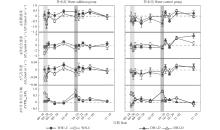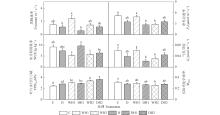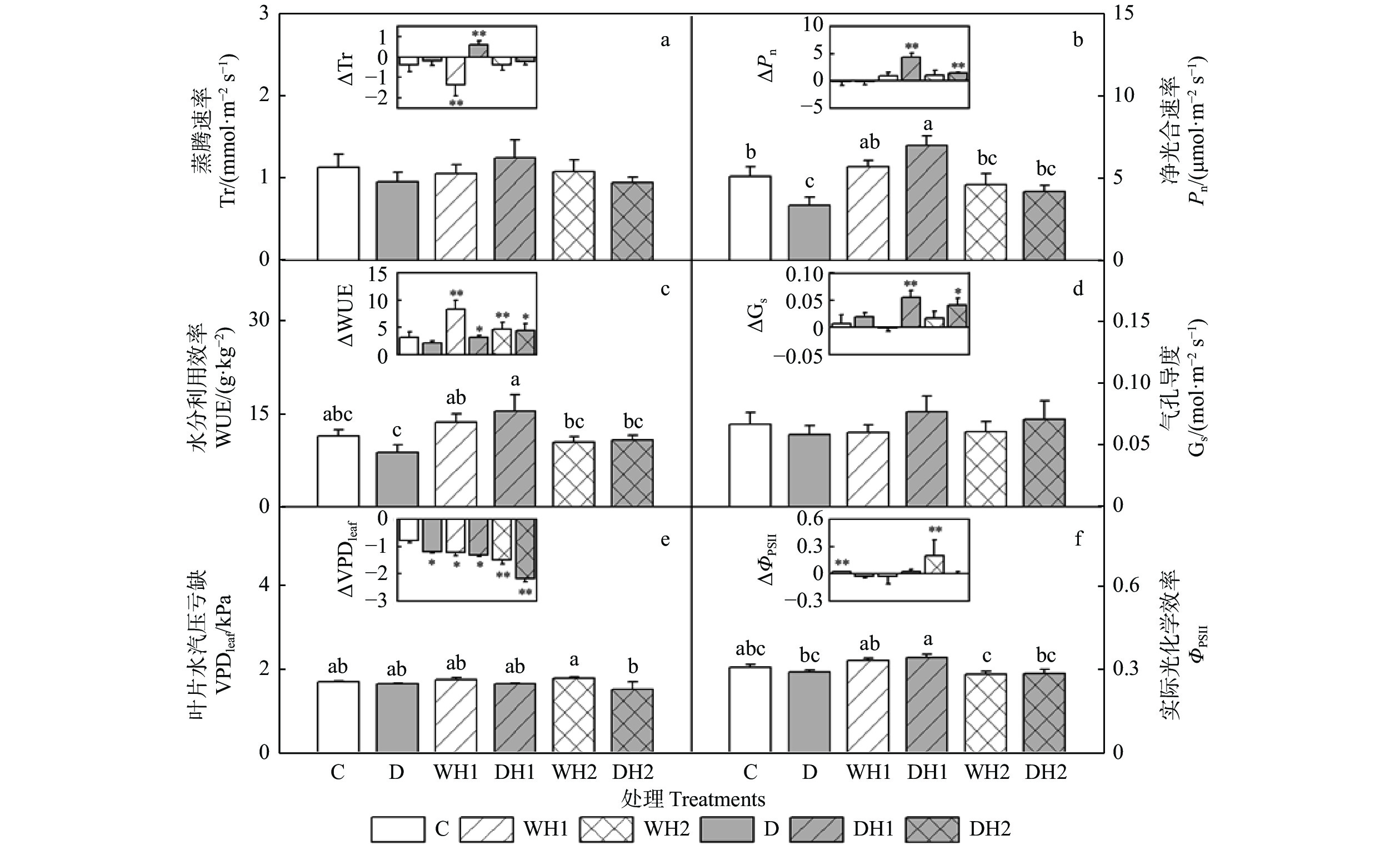

林业科学 ›› 2023, Vol. 59 ›› Issue (3): 104-114.doi: 10.11707/j.1001-7488.LYKX20210944
刘南1( ),曲鲁平1,*,汤行昊2,余海霞1,张子雷1,王浩1,邵长亮3,董刚4
),曲鲁平1,*,汤行昊2,余海霞1,张子雷1,王浩1,邵长亮3,董刚4
收稿日期:2021-12-26
出版日期:2023-03-25
发布日期:2023-05-27
通讯作者:
曲鲁平
E-mail:1200431006@fafu.edu.cn
基金资助:
Nan Liu1( ),Luping Qu1,*,Xinghao Tang2,Haixia Yu1,Zilei Zhang1,Hao Wang1,Changliang Shao3,Gang Dong4
),Luping Qu1,*,Xinghao Tang2,Haixia Yu1,Zilei Zhang1,Hao Wang1,Changliang Shao3,Gang Dong4
Received:2021-12-26
Online:2023-03-25
Published:2023-05-27
Contact:
Luping Qu
E-mail:1200431006@fafu.edu.cn
摘要:
目的: 探究木荷苗木光合特性与生长速率在控水和补水条件下对热浪频次的响应,为揭示木荷对极端高温事件的适应机制提供理论依据。方法: 以亚热带主要阔叶树种木荷苗木为试验材料,通过人工热浪模拟装置模拟自然热浪发生,构建控水和补水与不同热浪频次(无热浪、单次热浪、2次热浪)处理,分析木荷光合特性与生长速率在控水和补水条件下对不同频次热浪胁迫的抗性和恢复能力的差异。结果: 1) 补水条件下,单次热浪对木荷光合特性影响较弱,木荷可通过增加蒸腾速率(Tr)降低叶片温度,水分利用效率(WUE)显著降低,净光合速率(Pn)未出现显著变化;2) 控水条件下,单次热浪使木荷Pn在热浪阶段显著下降49%,未见Tr和WUE显著变化,但显著减缓热浪后木荷光合特性恢复过程;3) 2次热浪频次下,无论控水还是补水条件,木荷Pn在热浪阶段均显著下降(约46%和32%),虽然热浪后可恢复,但恢复过程受阻;多次热浪的影响存在累加效应,木荷对热浪胁迫的抗性和恢复能力减弱。结论: 控水和补水条件下,木荷光合特性与生长速率对不同频次热浪胁迫的抗性和恢复能力存在差异。补水条件下,木荷可通过生理调节机制保持较好的高温抗性,但该机制在控水条件下未发挥功效。高温与干旱复合胁迫显著影响木荷光合特性与生长速率,复合胁迫的影响强度超过单一因素影响的简单叠加。亚热带地区季节性高温与干旱复合胁迫或高频连续热浪的发生,可能显著改变木荷林的结构和功能,影响生态系统的稳定性和可持续性。
中图分类号:
刘南,曲鲁平,汤行昊,余海霞,张子雷,王浩,邵长亮,董刚. 水分条件和热浪频次对木荷苗木光合特性与生长速率的影响[J]. 林业科学, 2023, 59(3): 104-114.
Nan Liu,Luping Qu,Xinghao Tang,Haixia Yu,Zilei Zhang,Hao Wang,Changliang Shao,Gang Dong. Effects of Water Conditions and Heat Wave Frequency on the Photosynthetic Characteristics and Growth Rate of Schima superba Seedlings[J]. Scientia Silvae Sinicae, 2023, 59(3): 104-114.

图2
控水和补水条件及不同频次热浪下的木荷光合指标绝对差值动态变化 图中数据点为控水和补水条件下,热浪组与非热浪组之间光合指标的差值,WH1-C:补水单次热浪处理组与对照组之间光合指标的差值;WH2-C:补水2次热浪处理组与对照组之间光合指标的差值;DH1-D:控水单次热浪处理组与干旱组之间光合指标的差值;DH2-D:控水2次热浪处理组与干旱组之间光合指标的差值。其中,负值表示热浪产生的抑制作用;正值表示热浪产生的促进作用。图中浅灰色区域为第1次模拟热浪阶段,深灰色区域为第2次模拟热浪阶段。The plots in the figure depict the difference (Δ) of photosynthetic indexes between heat wave and non-heat wave groups, under normal and abundant water supply; WH1-C: the difference between the single heat wave treatment group and the control group (abundant water supply); WH2-C: the difference between the two heat wave group and the control group (abundant water supply); DH1-D: the difference between the single heat wave treatment group and the control group (normal water supply); DH2-D: the difference between the two heat wave group and the control group (normal water supply). Negative value indicates inhibition by the heat wave(s); positive values indicate stimulation by heat wave(s). The light gray area in the figures depicts the first imposed heat wave, and the dark gray area is the second imposed heat wave."

表1
控水和补水条件及不同频次热浪下木荷光合指标影响的双因素方差分析①"
| 处理Treatment | 自由度df | P值(P-value) | |||||
| 蒸腾速率Tr/ (mmol·m?2 s?1) | 净光合速率Pn/(μmol·m?2 s?1) | 水分利用效率WUE/(g·kg?1) | 气孔导度Gs /(mol· m?2 s?1) | 叶片蒸汽压亏缺VPDleaf/kPa | 实际光化学效率ΦPSII | ||
| 控水 Water control (a) | 1 | 0.017 | 0.007 | 0.007 | 0.027 | 0.819 | 0.671 |
| 热浪 Heat wave (b) | 2 | 0.684 | 0.044 | 0.237 | 0.307 | <0.001 | <0.001 |
| a ×b | 2 | 0.005 | 0.006 | <0.001 | 0.011 | 0.001 | 0.495 |

图3
模拟热浪最后1日控水和补水及不同热浪频次下木荷光合指标变化 图中数据为10−19光合指标数据(平均值±标准误差),不同字母表示处理间差异显著(P < 0.05,邓肯检验)。The data in this figure depict the photosynthetic parameter data on 10−19 (mean ± SE), i.e. the last day of the second heat wave period. Different letters indicate significant differences between treatments (P < 0.05, Duncan’s test)."

表2
控水与补水条件下不同频次热浪对木荷光合指标恢复过程影响的重复测定方差分析①"
| 处理Treatment | 自由度df | P | |||||
| 蒸腾速率Tr/(mmol·m?2 s?1) | 净光合速率Pn /(μmol·m?2 s?1) | 水分利用效率WUE /(g·kg?1 ) | 气孔导度Gs /(mol·m?2 s?1) | 叶片蒸汽压亏缺VPDleaf/kPa | 实际光化学效率ΦPSII | ||
| 控水 Water control (a) | 1 | 0.210 | 0.108 | 0.151 | 0.274 | 0.961 | 0.206 |
| 热浪 Heat wave (b) | 2 | 0.192 | 0.002 | 0.060 | 0.244 | <0.001 | 0.022 |
| a × b | 2 | 0.424 | 0.013 | 0.041 | 0.896 | 0.137 | 0.377 |
| 时间Time(c) | 3 | <0.001 | <0.001 | <0.001 | <0.001 | <0.001 | 0.001 |
| a × c | 3 | 0.420 | 0.768 | 0.066 | 0.916 | 0.723 | 0.454 |
| b × c | 6 | 0.033 | 0.005 | <0.001 | 0.880 | <0.001 | 0.436 |
| a ×b×c | 6 | 0.193 | 0.002 | 0.014 | 0.348 | 0.017 | 0.624 |

图6
热浪处理30天后不同水分处理及热浪频次下的木荷叶片光合指标(大图)及恢复(小图)情况 图中数据为11–19光合指标数据(平均值± 标准误差),不同字母表示处理间差异显著(P < 0.05,邓肯检验)。小图中Δ表示该指标在热浪后30日(11–19日)与第2次热浪事件最后1日(10–19日)差值。图中* 表示P < 0.05;** 表示P < 0.05(配对样本t检验)。The data in this figure was the photosynthetic parameters data in 11-19 (Mean ± SE). Different letters indicate significant differences between treatments (P < 0.05, Duncan test). Δ-value in the small figure indicated the differences between the value 30-days after heat waves and the last day during second heat wave event. Level of significance are * P < 0.05; ** P < 0.01 (by paired t-tests), respectively."

表3
控水与补水条件下不同频次热浪对木荷生长速率的影响(均值± 标准误)①"
| 处理Treatment | 苗高H0 /cm | 苗高H1 /cm | 苗高相对增长率RGR-H/(mm·month?1) | 地径B0/ mm | 地径B1/mm | 地径相对增长率RGR-B/ (mm·month?1) |
| C | 47.96±2.82 | 52.28±2.82 | 0.17±0.07 | 4.26±0.21 | 6.58±0.40 | 0.08±0.01 |
| D | 50.12±1.26 | 56.74±2.27 | 0.24±0.12 | 3.94±0.24 | 5.92±0.24 | 0.08±0.01 |
| WH1 | 43.34±4.53 | 48.50±5.29 | 0.22±0.04 | 4.65±0.17 | 6.09±0.28 | 0.05±0.01 |
| DH1 | 46.80±3.57 | 53.18±3.96 | 0.25±0.18 | 4.78±0.12 | 6.44±0.30 | 0.06±0.01 |
| WH2 | 53.76±2.73 | 59.12±3.97 | 0.18±0.10 | 4.21±0.24 | 6.75±0.21 | 0.09±0.01 |
| DH2 | 53.82±1.73 | 60.56±2.55 | 0.23±0.10 | 4.31±0.59 | 6.64±0.20 | 0.09±0.01 |
| 陈 芳, 华国栋 木荷在广东省林业建设中的应用. 林业与环境科学, 2017, 33 (4): 119- 122. | |
| Chen F, Hua G D The application of Schima superba in Guangdong forestry construction . Forestry and Environmental Science, 2017, 33 (4): 119- 122. | |
|
李 荣, 党 维, 蔡 靖, 等 6个耐旱树种木质部结构与栓塞脆弱性的关系. 植物生态学报, 2016, 40 (3): 255- 263.
doi: 10.17521/cjpe.2015.0260 |
|
|
Li R, Dang W, Cai J, et al Relationships between xylem structure and embolism vulnerability in six species of drought tolerance trees. Chinese Journal of Plant Ecology, 2016, 40 (3): 255- 263.
doi: 10.17521/cjpe.2015.0260 |
|
|
李永华, 李 臻, 辛智鸣, 等 形态变化对叶片表面温度的影响. 植物生态学报, 2018, 42 (2): 202- 208.
doi: 10.17521/cjpe.2017.0127 |
|
|
Li Y H, Li Z, Xin Z M, et al Effects of leaf shape plasticity on leaf surface temperature. Chinese Journal of Plant Ecology, 2018, 42 (2): 202- 208.
doi: 10.17521/cjpe.2017.0127 |
|
| 柳翼飞. 2012. 木荷(Schima superba)抗寒耐热性研究. 临安: 浙江农林大学. | |
| Liu Y F. 2012. Studies on cold and heat resistance of Schima superba. Lin'an: Zhejiang A & F University. [in Chinese] | |
| 倪 健 中国木荷及木荷林的地理分布与气候的关系. 植物资源与环境, 1996, (3): 29- 35. | |
| Ni J Relationship between geographical distribution of Schima superba, its forest and climate in China . Journal of Plant Resources and Environment, 1996, (3): 29- 35. | |
| 苏丽鳗, 赵玉佳, 叶宏萌, 等 武夷山国家公园不同土地利用类型土壤粒径分布与分形特征. 武夷学院学报, 2022, 41 (03): 16- 21. | |
| Su L M, ZhaoY J, Ye H M, et al Soil particle size distribution and fractal characteristics of different land use types in Wuyishan National Park. Journal of Wuyi University, 2022, 41 (03): 16- 21. | |
| 孙谷畴, 曾小平, 刘晓静, 等 适度高温胁迫对亚热带森林3种建群树种幼树光合作用的影响. 生态学报, 2007, (4): 1283- 1291. | |
| Sun G C, Zeng X P, Liu X J, et al Effects of moderate high-temperature stress on photosynthesis in saplings of the three dominant tree species of subtropical forest. Acta Ecologica Sinica, 2007, (4): 1283- 1291. | |
| 王 彬, 田正凤, 应彬彬, 等 高温胁迫对樟树光合性能的影响. 浙江农林大学学报, 2019, 36 (1): 47- 53. | |
| Wang B, Tian Z F, Ying B B, et al Photosynthetic abilities in Cinnamomum camphorawith high temperature stress . Journal of Zhejiang A & F University, 2019, 36 (1): 47- 53. | |
|
张小燕, 朱 俊, 曹坤芳 两种红树植物不同种源幼苗对模拟高温热浪的光合生理响应差异. 植物科学学报, 2021, 39 (4): 424- 432.
doi: 10.11913/PSJ.2095-0837.2021.40424 |
|
|
Zhang X Y, Zhu J, Cao K F Differences in photosynthetic responses to simulated heat wave in seedlings of two mangrove species from different provenances. Plant Science Journal, 2021, 39 (4): 424- 432.
doi: 10.11913/PSJ.2095-0837.2021.40424 |
|
|
张燕红, 吴永波, 刘 璇, 等 高温和干旱胁迫对杨树幼苗光合性能和抗氧化酶系统的影响. 东北林业大学学报, 2017, 45 (11): 32- 38.
doi: 10.3969/j.issn.1000-5382.2017.11.007 |
|
|
Zhang Y H, Wu Y B, Liu X, et al Effects of elevated temperature and drought on photosynthetic characteristics and antioxidant enzyme system of poplar seedlings. Journal of Northeast Forestry University, 2017, 45 (11): 32- 38.
doi: 10.3969/j.issn.1000-5382.2017.11.007 |
|
| 赵 青, 刘 爽, 陈燕菲, 等 武夷山不同林龄甜槠林土壤呼吸特征及影响因素. 生态学报, 2021, 41 (6): 2326- 2338. | |
| Zhao Q, Liu S, Chen Y F, et al Soil respiration characteristics and influencing factors of Castanopsiseyrei forest in different forest ages in Wuyi Mountain . Acta Ecologica Sinica, 2021, 41 (6): 2326- 2338. | |
|
钟连香, 严 理, 秦武明, 等 干旱胁迫对木荷幼苗生长及生理特性的影响. 山西农业科学, 2016, 44 (8): 1103- 1107.
doi: 10.3969/j.issn.1002-2481.2016.08.12 |
|
|
Zhong L X, Yan L, Qin W M, et al Effect of drought stress on growth and physiological characters of Schima superba's seedling . Journal of Shanxi Agricultural Sciences, 2016, 44 (8): 1103- 1107.
doi: 10.3969/j.issn.1002-2481.2016.08.12 |
|
|
Ahrens C W, Challis A, Byrne M, et al Repeated extreme heatwaves result in higher leaf thermal tolerances and greater safety margins. The New Phytologist, 2021, 232 (3): 1212- 1225.
doi: 10.1111/nph.17640 |
|
|
Ameye M, Wertin T M, Bauweraerts I, et al The effect of induced heat waves on Pinus taeda and Quercus rubra seedlings in ambient and elevated CO2 atmospheres . The New Phytologist, 2012, 196 (2): 448- 461.
doi: 10.1111/j.1469-8137.2012.04267.x |
|
| Aparecido L M T, Woo S, Suazo C, et al High water use in desert plants exposed to extreme heat. Energy & Ecology, 2020, 23 (8): 1189- 1200. | |
|
Aspinwall M J, Drake J E, Campany C, et al Convergent acclimation of leaf photosynthesis and respiration to prevailing ambient temperatures under current and warmer climates in Eucalyptus tereticornis. The New Phytologist, 2016, 212 (2): 354- 367.
doi: 10.1111/nph.14035 |
|
|
Birami B, Gattmann M, Heyer A G, et al Heat waves alter carbon allocation and increase mortality of Aleppo pine under dry conditions . Frontiers in Forests and Global Change, 2018, 1, 8.
doi: 10.3389/ffgc.2018.00008 |
|
|
Bueno A, Alfarhan A, Arand K, et al Effects of temperature on the cuticular transpiration barrier of two desert plants with water-spender and water-saver strategies. Journal of Experimental Botany, 2019, 70 (5): 1613- 1625.
doi: 10.1093/jxb/erz018 |
|
|
De Boeck H J, Dreesen F E, Janssens I A, et al Climatic characteristics of heat waves and their simulation in plant experiments. Global Change Biology, 2010, 16 (7): 1992- 2000.
doi: 10.1111/j.1365-2486.2009.02049.x |
|
|
De Boeck H J, Velde H V D, Groote T D, et al Ideas and perspectives: heat stress: more than hot air. Biogeosciences, 2016, 13 (20): 5821- 5825.
doi: 10.5194/bg-13-5821-2016 |
|
|
Drake J E, Tjoelker M G, Vårhammar A, et al Trees tolerate an extreme heatwave via sustained transpirational cooling and increased leaf thermal tolerance. Global Change Biology, 2018, 24 (6): 2390- 2402.
doi: 10.1111/gcb.14037 |
|
|
Duursma R A, Blackman C J, Lopéz R, et al On the minimum leaf conductance: its role in models of plant water use, and ecological and environmental controls. The New Phytologist, 2019, 221 (2): 693- 705.
doi: 10.1111/nph.15395 |
|
|
Guha A, Han J, Cummings C, et al Differential ecophysiological responses and resilience to heat wave events in four co-occurring temperate tree species. Environmental Research Letters, 2018, 13 (6): 065008.
doi: 10.1088/1748-9326/aabcd8 |
|
| Ingrisch J, Bahn M Towards a comparable quantification of resilience. Trends in Ecology & Evolution, 2018, 33 (4): 251- 259. | |
| IPCC 2021. Climate Change 2021: The physical science basis. Contribution of Working Group I to the Sixth Assessment Report of the Intergovernmental Panel on Climate Change. Cambridge University Press. | |
|
Kuczyńska-Wiśnik D, Matuszewska E, Laskowska E Escherichia coli heat-shock proteins IbpA and IbpB affect biofilm formation by influencing the level of extracellular indole. Microbiology, 2010, 156 (1): 148- 157.
doi: 10.1099/mic.0.032334-0 |
|
| McDowell N G, Sevanto S. 2010. The mechanisms of carbon starvation: how, when, or does it even occur at all? The New Phytologist, 186(2): 264-266. | |
| Michaletz S T, Weiser M D, McDowell N G, et al The energetic and carbon economic origins of leaf thermoregulation. Nature Plants, 2016, 2 (9): 1- 9. | |
|
O'sullivan O S, Heskel M A, Reich P B, et al Thermal limits of leaf metabolism across biomes. Global Change Biology, 2017, 23 (1): 209- 223.
doi: 10.1111/gcb.13477 |
|
|
Perez T M, Feeley K J Photosynthetic heat tolerances and extreme leaf temperatures. Functional Ecology, 2020, 34 (11): 2236- 2245.
doi: 10.1111/1365-2435.13658 |
|
| Perkins S E A review on the scientific understanding of heatwaves-their measurement, driving mechanisms, and changes at the global scale. Atmospheric Research, 2015, 164, 242- 267. | |
|
Perkins S E, Alexander L V On the measurement of heat waves. Journal of Climate, 2013, 26 (13): 4500- 4517.
doi: 10.1175/JCLI-D-12-00383.1 |
|
|
Qu L, De Boeck H J, Fan H, et al Diverging responses of two subtropical tree species (Schima superba and Cunninghamia lanceolata) to heat waves . Forests, 2020a, 11 (5): 513.
doi: 10.3390/f11050513 |
|
| Qu L, Chen J, Dong G, et al. 2016. Heat waves reduce ecosystem carbon sink strength in a Eurasian meadow steppe. Environmental Research, 144(Pt B): 39−48. | |
| Qu L, Dong G, De Boeck H J, et al Joint forcing by heat waves and mowing poses a threat to grassland ecosystems: Evidence from a manipulative experiment. Land Degradation & Development, 2020b, 31 (7): 785- 800. | |
| Rehschuh R, Ruehr N K. 2021. Diverging responses of water and carbon relations during and after heat and hot drought stress in Pinus sylvestris. Tree Physiology, https://doi.org/10.1093/treephys/tpab141. | |
| Ruehr N K, Gast A, Weber C, et al Water availability as dominant control of heat stress responses in two contrasting tree species. Tree Physiology, 2016, 36 (2): 164- 178. | |
|
Ruehr N K, Grote R, Mayr S, et al Beyond the extreme: recovery of carbon and water relations in woody plants following heat and drought stress. Tree Physiology, 2019, 39 (8): 1285- 1299.
doi: 10.1093/treephys/tpz032 |
|
|
Sullivan M J P, Lewis S L, Affum-Baffoe K, et al Long-term thermal sensitivity of Earth’s tropical forests. Science, 2020, 368 (6493): 869- 874.
doi: 10.1126/science.aaw7578 |
|
| Teskey R, Wertin T, Bauweraerts I, et al. 2015. Responses of tree species to heat waves and extreme heat events. Plant, Cell & Environment, 38(9): 1699−1712. | |
| Vogel M M, Zscheischler J, Fischer E M, et al. 2020. Development of future heatwaves for different hazard thresholds. Journal of Geophysical Research: Atmospheres, 125(9): e2019JD032070. | |
| Xu Z Z, Zhou G S Effects of water stress and high nocturnal temperature on photosynthesis and nitrogen level of a perennial grass Leymus chinensis. Plant and Soil, 2005, 269 (1): 131- 139. | |
| You Q, Jiang Z, Kong L, et al A comparison of heat wave climatologies and trends in China based on multiple definitions. Climate Dynamics, 2017, 48 (11): 3975- 3989. |
| [1] | 潘天天,李彦,王忠媛,陆世通,叶琳峰,陈森,谢江波. 湿润区3种杉科植物枝和根木质部的水力功能与解剖结构的关系[J]. 林业科学, 2020, 56(12): 49-59. |
| [2] | 张守科,方林鑫,王毅,张威,舒金平,汪阳东,王浩杰. 基于组成型抗性性状的油茶抗茶籽象的评价模型[J]. 林业科学, 2020, 56(12): 67-74. |
| [3] | 王志刚, 苏智, 刘明虎, 赵英铭, 张格, 崔振荣, 淡慧丽, 陈星明. 新疆杨与北抗杨抗光肩星天牛特性的比较[J]. 林业科学, 2018, 54(9): 89-96. |
| [4] | 陈伟, 杨飞, 王卷乐, 程淑兰. 冰雪冻灾干扰下的亚热带森林生态系统恢复力综合定量评价——以湖南省道县为例[J]. 林业科学, 2018, 54(6): 1-8. |
| [5] | 曹瑞致, 张馨宇, 杨大伟, 夏广东, 董娟娥. 剥皮对杜仲次生代谢物含量及伤害修复能力的影响[J]. 林业科学, 2017, 53(6): 151-158. |
| [6] | 白宇清, 谢利娟, 王定跃. 不同遮荫、土壤排水处理对毛棉杜鹃幼苗生长及光合特性的影响[J]. 林业科学, 2017, 53(2): 44-53. |
| [7] | 郎莹, 汪明. 春夏两季连翘光合作用的土壤水分阈值效应及生产力分级[J]. 林业科学, 2016, 52(2): 38-46. |
| [8] | 王晓丽, 李海平, 贾程宇, 段立清. 茉莉酸诱导青杨抗性及核型多角体病毒对舞毒蛾幼虫食物利用的影响[J]. 林业科学, 2016, 52(10): 96-101. |
| [9] | 曹庆杰, 迟德富. 杨树品系抗杨干象水平及其与木质部和韧皮部硬度等关系[J]. 林业科学, 2015, 51(5): 56-67. |
| [10] | 孙妙, 杨周婷, 张存莉, 魏安智, 史伟. 中国沙棘种子的水引发技术及其抗性生理效应[J]. 林业科学, 2014, 50(12): 32-39. |
| [11] | 张丽娜, 朱天辉, 彭艳, 郑磊, 赵芳. 抗菌蛋白AMP对杂交竹梢枯病防治效果及其抗性相关酶活性的影响[J]. 林业科学, 2014, 50(11): 82-89. |
| [12] | 张雄帅, 周国娜, 高宝嘉. 油松毛虫体内酶系对油松诱导抗性的响应机制[J]. 林业科学, 2014, 50(10): 181-187. |
| [13] | 冯春富;严善春;鲁艺芳;胡晓. 兴安落叶松诱导抗性对舞毒蛾幼虫解毒酶活性的影响[J]. 林业科学, 2011, 47(8): 102-107. |
| [14] | 刘静;黄艳艳;翁曼丽;罗磊;张虹;王长宪;牛庆霖;冯殿齐. TCS基因转化泡桐及抗病能力[J]. 林业科学, 2011, 47(5): 171-176. |
| [15] | 徐莉莉;姜卫兵;韩健;翁忙玲;程春燕;化香平. 初夏叶面喷施KH2PO4和蔗糖对红叶桃叶片色素变化及净光合速率的影响[J]. 林业科学, 2011, 47(3): 170-174. |
| 阅读次数 | ||||||
|
全文 |
|
|||||
|
摘要 |
|
|||||